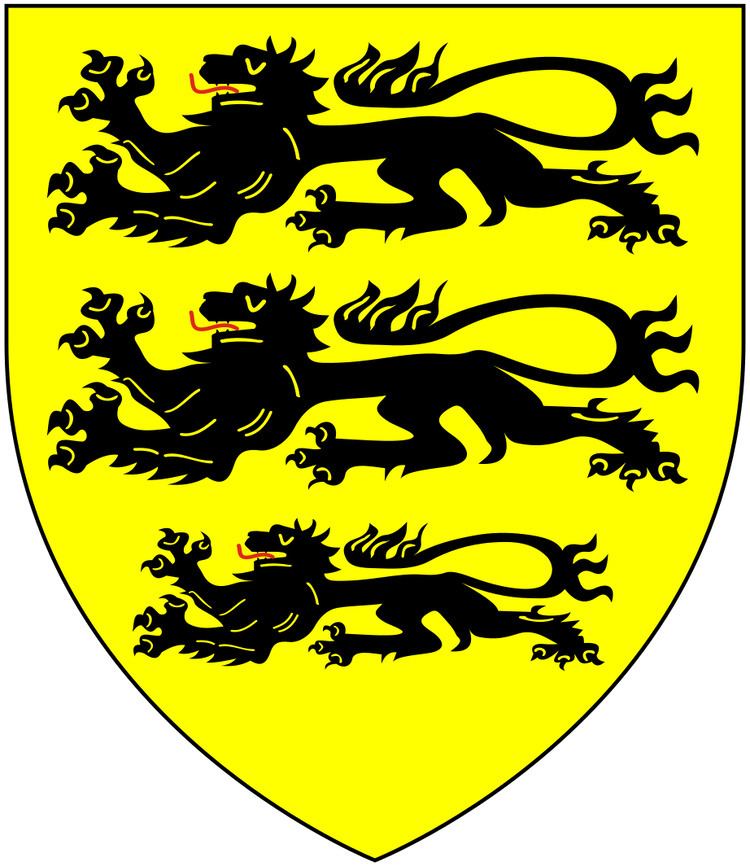Died 1311 | ||
 | ||
Nicholas Carew (died 1311), feudal lord of Carew Castle in Pembrokeshire, feudal lord of Odrone (mod. Idrone, County Carlow) in Ireland and lord of the manor of Moulsford in Berkshire (since 1974 in Oxfordshire), was a soldier. He was the first of the Carew family to form a connection with the English county of Devon, where his descendants became very prominent until modern times. His descendants obtained three Carew baronetcies and four peerage titles, namely Baron Carew (1605) in the Peerage of England (for Sir Sir George Carew (1555–1629), created in 1626 Earl of Totnes) and Baron Carew (1834) in the Peerage of Ireland and Baron Carew (1838) of Castle Boro in the County of Wexford, in the Peerage of the United Kingdom (both for Robert Shapland Carew (1787–1856)).
Contents
Origins
He was the eldest son and heir of Nicholas de Carew (died 1297), feudal lord of Carew Castle in Pembrokeshire, lord of the manor of Molesford in Berkshire and jure uxoris feudal lord of Odrone, by his wife Avice Tuitt, daughter and heiress of Richard Tuitt of Marston in County Westmeath, Ireland, whose family had acquired the Barony of Odrone by an earlier marriage to the heiress of Odrone.
Career
As Nic(olae)us de Carru, D(omi)n(u)s de Mulesford ("Nicholas de Carew, lord of the manor of Moulsford") he was one of 103 signatories of the Barons' Letter of 1301 addressed to Pope Boniface VIII as a repudiation of his claim of feudal overlordship of Scotland and as a defence of the rights of King King Edward I of England as overlord of that kingdom.
"Baron Carew"
In 1300–1 he was summoned to Parliament by writ of King Edward I (1272–1307) as Dominus de Moulsford ("lord of the manor of Moulsford") by which he is deemed to have become Baron Carew. He is called "Baron Carew" in various sources, but a peerage title Baron Carew at this early date is not mentioned in the authoritative Complete Peerage (1887–98) by George Edward Cokayne. Pole however states that he was summoned to Parliament by writ of King Edward I (1272–1307), which would have made him a baron. If so, there is no clear descent of such barony, and no explanation of why it had no clear ending. According to Debrett's Peerage and Baronetage, 1968: "For several generations the heads of the family are described as Barons of Carew and Hidron, but none of them sat in Parliament with the exception of Nicholas de Carew who subscribed to the celebrated Barons' letter to the Pope in 1300".
Caerlaverock Roll
He was present at the Siege of Caerlaverock Castle in Scotland in 1301, during which his armorials were amongst those blazoned in French verse by English heralds in the Caerlaverock Roll of Arms, as follows:
An vaillant home e de grant losO lui, Nichole de Karru,Dont meinte foiz orent paruLi fait en couvert e en landeSur la felloune gent d'Irlande;Baniere ot jaune bien passable,O treis lyouns passans de sable.("A valliant man ... Nicholas de Carew, who many times appeared ... a banner of gold ... three lions passant of sable")
Marriage and children
He married Amicia (or Amy) Peverell, daughter of Hugh Peverell lord of the manor of Ermington in Devon, and heiress of her brother Sir John Peverell of Ermington, the last in the male line. By Amicia he had children including:
Landholdings
Through his wife he inherited several manors including:
